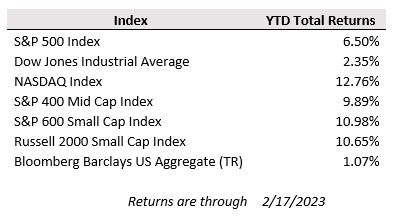Despite the considerable policy ground that has been covered so far in the Federal Reserve’s fight against inflation with interest rates being hiked by 4.50% and the central bank balance sheet being shrunk by over half a trillion in less than a year, U.S. economic data broadly has not yet shown much sign of yielding to the policy pressure, except for the most rate sensitive areas like housing. January’s data—from a blowout jobs report to a reacceleration in consumer spending—pointed to more work to be done by the Fed if it hopes to restore price stability by bringing inflation down to its year-over-year target of 2.0%. With last week’s inflation and retail sales reports providing further evidence of an economy that is running hot, rate hike expectations ramped up sharply and offset the positive takeaways of economic resilience. For the week, the S&P 500 ended down just 0.2%, while the Dow Jones ended even and the Nasdaq Composite rose 0.6%. Meanwhile, bond markets have given back their January price gains as the 5-year U.S. Treasury, which touched as low as 3.44% in January, has pushed back above its year-end starting point of 4.0%.
After a string of encouraging inflation reports to close out 2022, the January reports for the consumer and producer price indices gave pause to hopes for a smooth inflation descent. Consumer prices grew 0.5% during the month and were up 6.4% year-over-year, which overshot expectations for growth of 6.2%. Producer price growth was more concerning as PPI reaccelerated to 0.7% month-over-month (6.0% year-over-year), the highest monthly growth since last June, compared to expectations of a 0.4% increase and December’s 0.2% decline. Meanwhile, U.S. retail sales rose by an astounding 3% in January, the largest monthly increase in 20 years (excluding the months immediately after the pandemic relief bills in 2020 and 2021).
While there are some seasonal quirks in both the inflation and retail sales data sets, the resounding strength of these reports alongside other January data collectively bolster the Fed’s interest rate narrative of “higher for longer”. While the Federal Reserve had come into this year communicating expectations that the federal funds rate would be pushed above 5.0% and stay at those levels at least through the course of the year, fixed income markets reflected expectations for rates to be raised shy of 5% by this summer before being cut back down by at least 0.50% before the end of 2023. That disconnect has closed in recent weeks with markets now forecasting a rate peak above 5.25% (at least another 0.75% of hikes from today) and rates remaining above 5% throughout the year.
The bottom line of January’s data is that it paints a picture of greater than appreciated resilience for labor markets and the U.S. consumer, but it also indicates that the market was perhaps over optimistic on the path of inflation and monetary policy this year, which had been a strong contributor to the market rally to kick off the year. As accumulated excess pandemic savings dry up in the months ahead and inflation continues to bite into budgets, it will be important to monitor how well the U.S. consumer maintains spending momentum with the support of the robust employment backdrop. The week ahead will provide a bit more context on this front with updates on personal consumption, income, and savings for January and February consumer sentiment surveys on the docket.


